Affiliate links on Android Authority may earn us a commission. Learn more.
5G vs Gigabit LTE: the differences explained
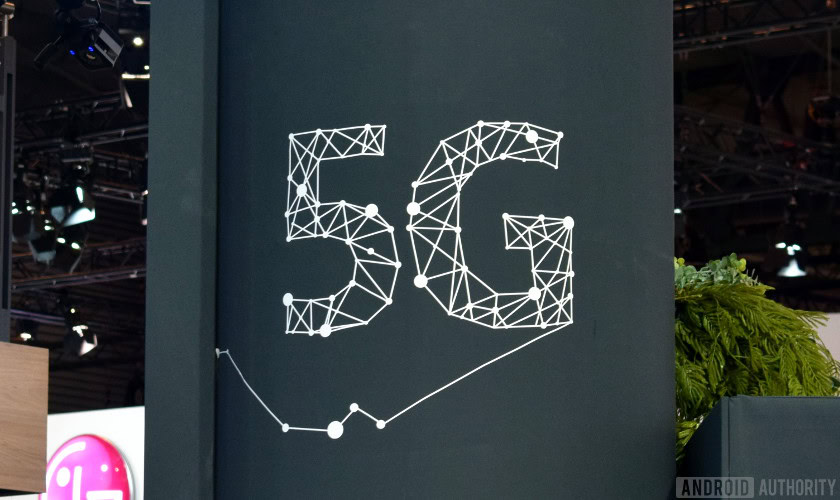
5G is coming this year, if some carriers are to be believed. But you won’t find a phone able to make use of 5G until at least 2019. Meanwhile, other networks and equipment manufacturers have been trialing Gigabit LTE for faster speeds from as far back as 2015. With AT&T trying to dupe customers with its “5G Evolution” plans as well, it has become increasingly difficult to know exactly what the world’s next-generation wireless networks are going to look like.
Read Next: When will your phone get 5G connection? | What is LTE Advanced?
Will we see true 5G soon? Is Gigabit LTE worse or just as good? Will I actually ever get to use either of them on my phone? Let’s tear down the differences between these two networking technologies and find out.
Technical standards
The problem with both 5G and Gigabit LTE is that various companies and carriers have been using the terms to describe different things. We’ve already explored some of the differences between 5G Non-Standalone and the (upcoming) 5G Standalone standard and what that means for products and use cases – put simply, 5G is not yet a single “thing”. Similarly, Gigabit LTE networks have been constructed using new high- and/or low-frequency spectrum, unlicensed spectrum, and aggregation from LTE and Wi-Fi signals. It has also been called LTE-Advanced, LTE Advanced Pro, and “pre-5G,” but the unifying factor is providing downloads speeds in excess of 1 Gbps.
There are lots of ways to achieve faster wireless data speeds, which is partly what’s leading to some of this confusion. Just so we’re all on the same page, we’ll defer to some details in the 3GPP standards to tell us what each technology requires to work and what it provides to consumers. The first specification that enables speeds over 1 Gbps arrived with Release 13, while the first 5G NSA specification came in Release 15.
| 5G New Radio (Release 15) | LTE-Advanced Pro (Release 13 & 14) | LTE-Advanced (Release 10 to 12) | |
|---|---|---|---|
Ideal Data Rate | 5G New Radio (Release 15) > 10 Gbps | LTE-Advanced Pro (Release 13 & 14) > 3 Gbps | LTE-Advanced (Release 10 to 12) > 1 Gbps |
Ideal Latency | 5G New Radio (Release 15) > 1ms | LTE-Advanced Pro (Release 13 & 14) > 2ms | LTE-Advanced (Release 10 to 12) ~10 ms |
Frequency Support | 5G New Radio (Release 15) Up to 40 GHz | LTE-Advanced Pro (Release 13 & 14) Up to 6 GHz | LTE-Advanced (Release 10 to 12) Up to 6 GHz |
Channel Bandwidth | 5G New Radio (Release 15) Up to 500 MHz | LTE-Advanced Pro (Release 13 & 14) Up to 20 MHz | LTE-Advanced (Release 10 to 12) Up to 20 MHz |
Max carriers | 5G New Radio (Release 15) 16 (LTE + NR) | LTE-Advanced Pro (Release 13 & 14) 32 | LTE-Advanced (Release 10 to 12) 5 |
Max Bandwidth | 5G New Radio (Release 15) 1000 MHz | LTE-Advanced Pro (Release 13 & 14) 640 MHz | LTE-Advanced (Release 10 to 12) 100 MHz |
MIMO antennas | 5G New Radio (Release 15) 64 to 256 | LTE-Advanced Pro (Release 13 & 14) 32 | LTE-Advanced (Release 10 to 12) 8 |
Spectrum Sharing | 5G New Radio (Release 15) mmWave & NR Dual Connectivity NR-based LAA+ NR MulteFire LTE-U | LTE-Advanced Pro (Release 13 & 14) LAA / eLAA LWA MulteFire CBRS / LSA LTE-U | LTE-Advanced (Release 10 to 12) LTE-U (Rel. 12) |
As you can see from the table above, there’s a gradual growth through these releases, introducing additional features and hardware support to push towards higher speeds. A few major themes go hand-in-hand with faster speeds; an increase in the number of carriers that can be aggregated together, larger MIMO, and support for a wider range of spectrum sharing techniques. The move to the 5G Non-Standalone (New Radio) specification aims to boost speeds further by adding in more spectrum and carriers in the sub 6 GHz and higher mmWave frequencies.
Both 5G and Gigabit LTE aim to boost speeds by increasing the range of frequencies available and the number of carriers transferring data.
In terms of speeds, introducing both LTE-Advanced Pro and 5G New Radio gets us past the 1 Gbps barrier. However, it’s worth mentioning at this stage that the peak user data rates are going to be much lower than these theoretical maximums.
Read Next: Forget mmWave, Wi-Fi is the real 5G
This is because actual speeds will depend on the type of spectrum available in your current area, such as a mmWave antenna or LAA small-cell hub, as well as the supporting technology packed into your phone. Having a 5G phone won’t guarantee faster than Gigabit LTE speeds.
We’ll take a look at where modems and devices fit into this picture a little later on. For now, here’s a closer look at the various technologies that go into these releases and how they relate to 5G vs Gigabit LTE.
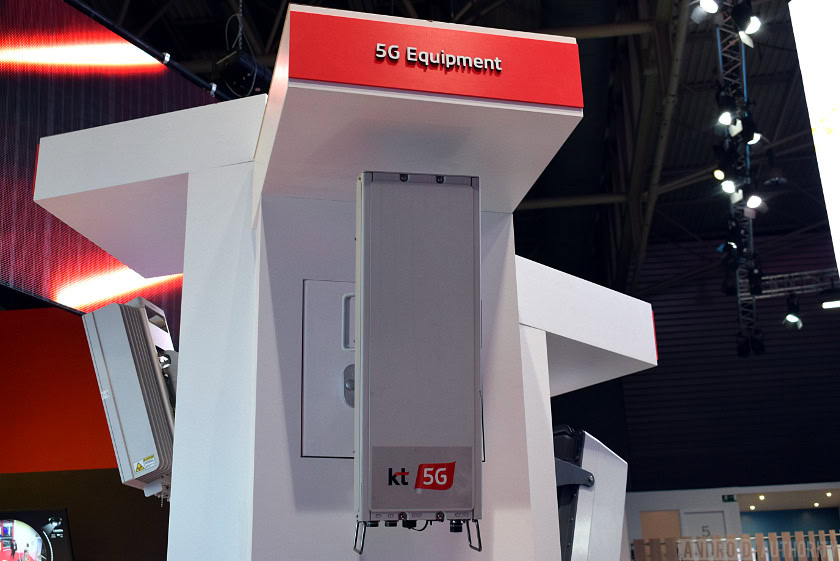
How they work
The key to improving data speeds is through carrier aggregation, which increases throughput by taking data from multiple sub-carrier bands. The first LTE networks and handsets only made use of a single 20 MHz carrier band, but LTE-Advanced introduced mixed carrier bands across LTE networks. This was followed by LTE-Advanced Pro which increased the number of bands further and began supporting a wide range of unlicensed spectrum technologies too. Unlicensed spectrum includes mixing in signals from Wi-Fi bands at 2.4 or 5 Ghz, and other small cell implementations around similar sub-6 GHz bands.
Multiple-input and multiple-output (MIMO) technology is also equally important. It’s a similar idea to carrier aggregation, as this stream of data can be sent in parallel, across multiple antennas for each carrier band. As well as being used to increase throughput, the same data can also be sent across these parallel antennas to check for errors and prevent packet losses. When it comes to 5G radios using mmWave technology, massive MIMO becomes even more important. This is because very high-frequency mmWave technology is more dependent on line-of-sight, so MIMO is essential to ensure messages can reach the destination handset intact.
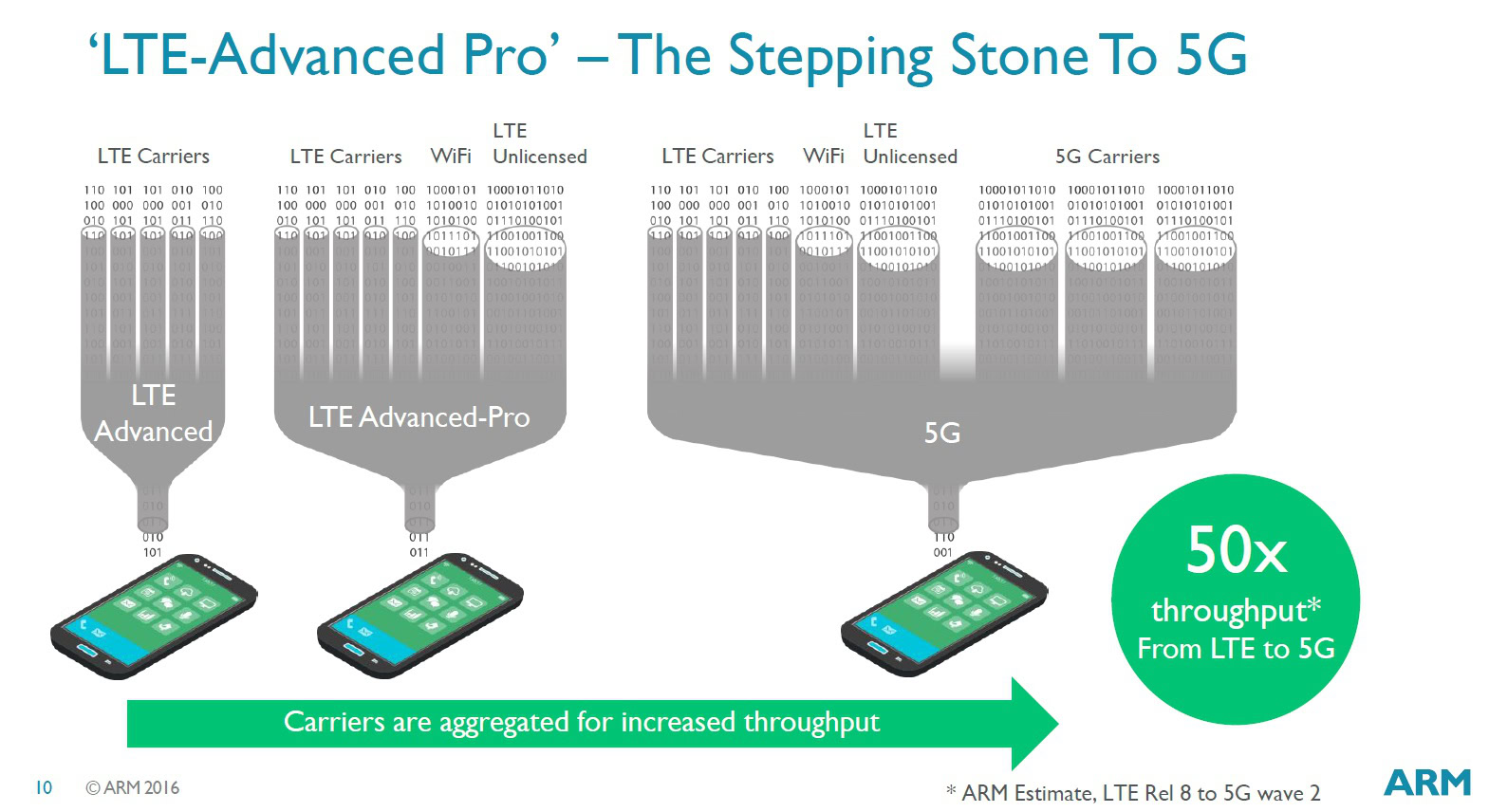
With Gigabit LTE, five or more LTE carrier bands are aggregated together to provide the higher peak data rate. This can come from a wide variety of spectrum, including sub 1 GHz long range low bands like T-Mobile’s 600 MHz spectrum. In built-up areas like inner cities, you may find these traditional LTE bands augmented with additional macro cells operating in unlicensed spectrum to further boost the number of available bands for aggregation and provide more bandwidth.
Aggregating from multiple carriers also has advantages for improved speeds at the edge of the cell network, because multiple weaker signals can be combined together for a higher throughput. Of course, to make use of these speeds you’ll need a smartphone with not only a compatible modem but also with a radio front end which is built to pick up the correct spectrum bands for your carrier.
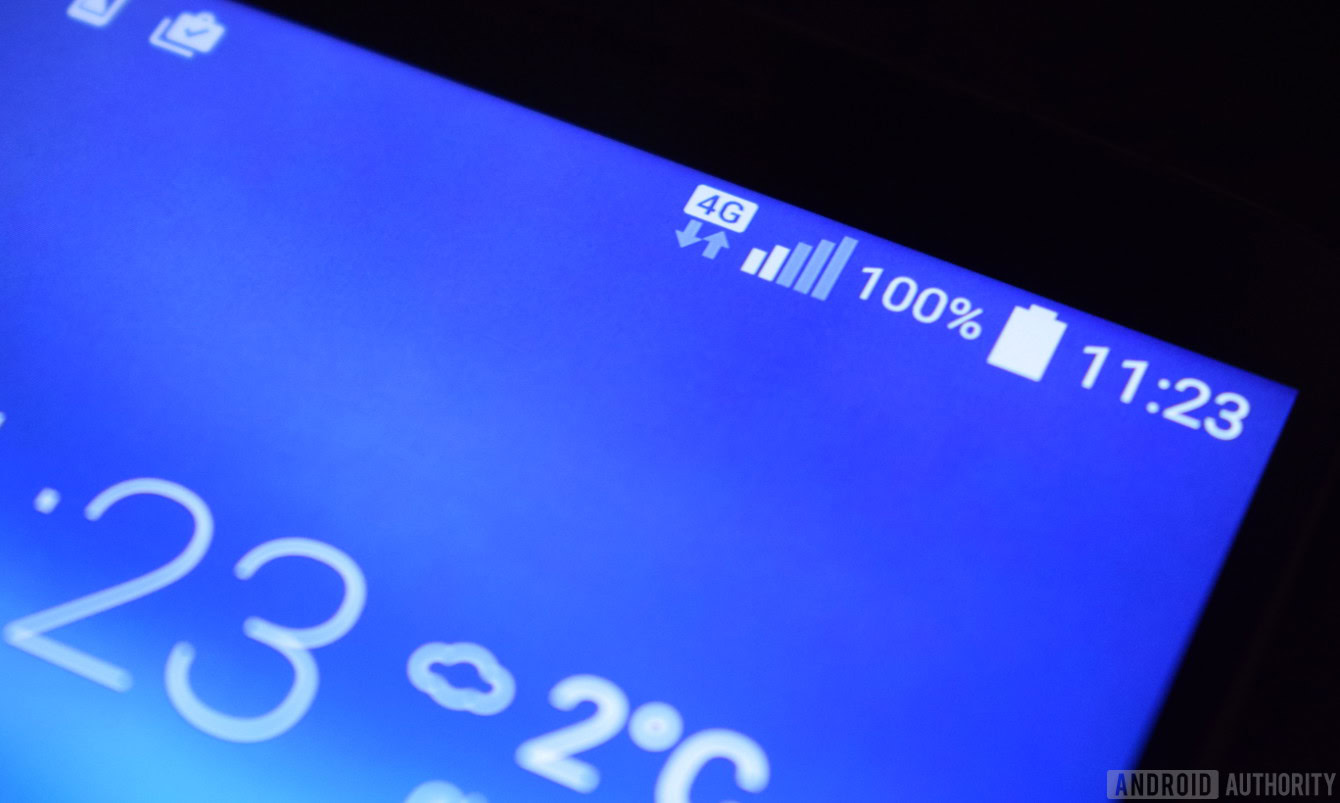
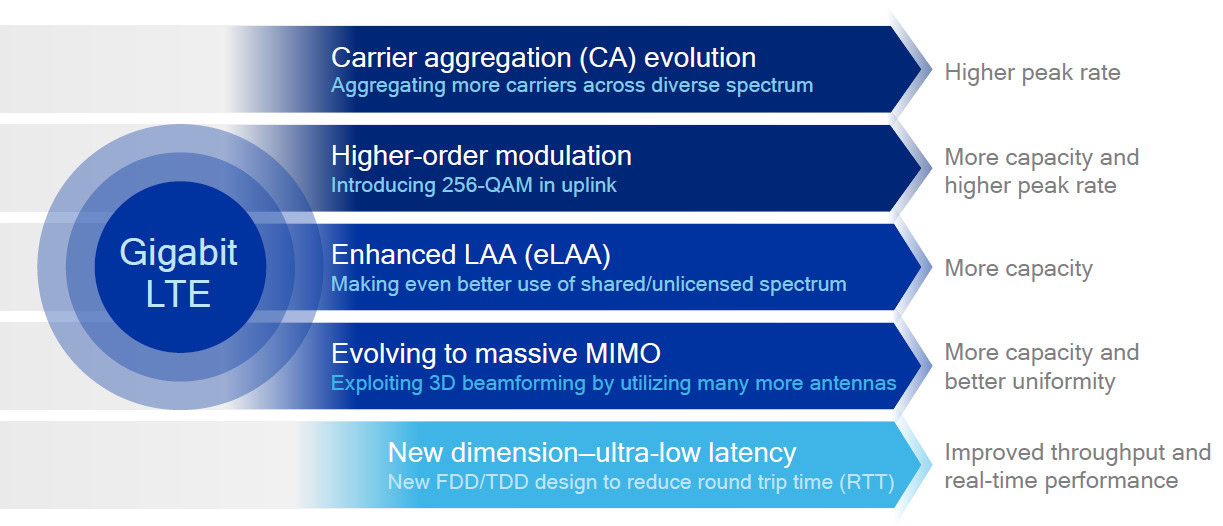
The first 5G networks will keep the familiar LTE anchor, augmenting what’s already achievable with Gigabit LTE with new mmWave and dedicated 5G spectrum in new bands. In other words, the first 5G networks will simply take this long-running aggregation idea to the next level, by opening up new frequency bands for use with mobile data.

It’s the move to new mmWave and other high-frequency bands that really separates 5G from Gigabit LTE, but making the switch is no simple feat.
These high frequencies are very easily blocked by walls and even your hand. That’s right, even holding your smartphone can be enough to prevent very high frequency data from reaching the antenna. 5G smartphone antennas need to be redesigned so they work with these more finicky frequencies. The radio frequency front end also has to be tuned to cater to these bands, which necessitates some lower-level product redesigns. That’s on top of the problems with rolling out 5G mmWave transmitters with beam-forming and other associated technologies.
Gigabit LTE is easier to put into products, as it's based on existing common radio technologies. 5G mmWave presents new design challenges.
In addition to smartphone-grade cellular broadband, Gigabit LTE and 5G New Radio also include a range of new communication technologies and protocols for emerging use cases. LTE Direct, LTE Broadcast, and C-V2X are designed to enable device-to-device connections without having to traverse large networks. There’s also support for IoT using eMTC and Narrow Band IoT technologies useful for everything from smart homes to drones.
Gigabit LTE is much easier to implement, as antenna array design is very similar to what’s used now and power draw stays mostly unchanged. Smartphone design and form factors can remain more or less the same using Gigabit LTE, while 5G smartphones will require some notable re-engineering.
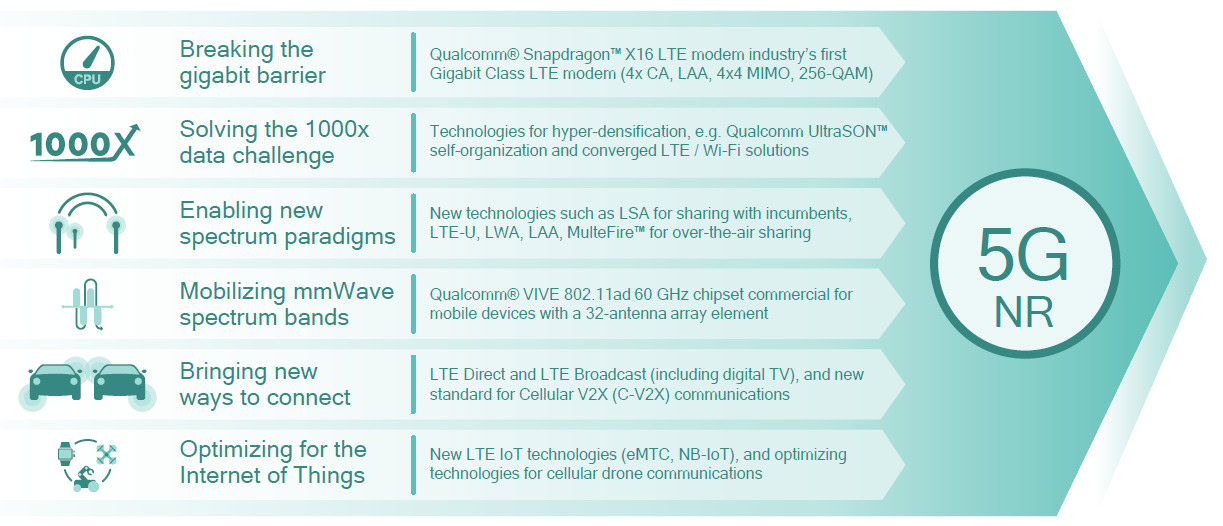
Which one should I care about?
With the huge marketability and potential paradigm shift of 5G, Gigabit LTE is perhaps a little too easy to overlook. The technology still offers major speed boosts to consumers and there’s still plenty of growth left in a lot of the world’s LTE networks. Just look at the data collected for some of the world’s fastest countries versus the U.S., much of Europe, India, and other countries. Carriers in those countries can clearly catch up with industry leaders like South Korea without needing 5G technologies.
For smartphones, Gigabit LTE can be used for even the toughest consumer mobile use cases, like streaming 4K video, which only requires 13 Mbps or so download speeds for real-time streaming. Of course, just being on a Gigabit LTE network doesn’t mean you’re actually going to see speeds of 1000 Mbps, but fibre broadband speeds in excess of 50 Mbps are common on these networks. Instead, 5G is going to be more of a revelation for mass IoT and very low latency use cases, such as self driving cars, rather than marking a major shift in the way mobile users experience day to day internet usage.
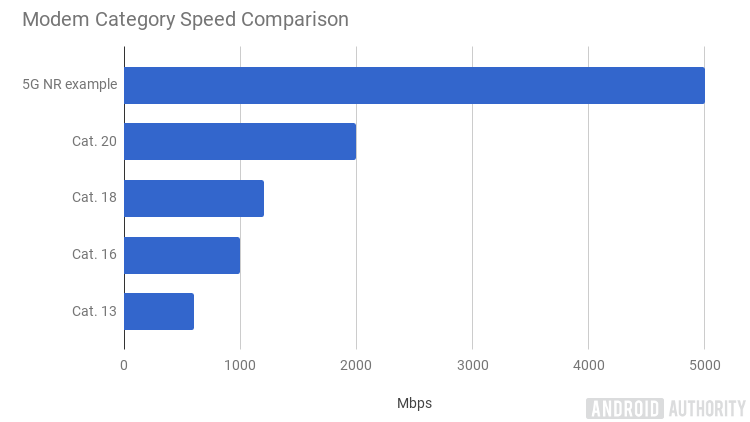
Practicality is also an important point to consider. 5G technology is going to require some notable re-engineering not just on the network hardware side, but also in devices. New modems and, more importantly, front end radio designs will be expensive and tricky to fit into existing mobile form factors. By comparison, Gigabit LTE is simple to implement, mostly scaling up existing networking LTE and Wi-Fi bands.
This isn’t to dismiss 5G as an important evolution in mobile networking. As well as faster speeds, additional bandwidth, and lower latency, 5G is set to revolutionize use cases across IoT, automotive, and connected industries, as well as enabling new, more efficient services when the 5G backend changes switch from today’s LTE core. However, the first 5G networks aren’t going to be online until at least 2019, and even then most will be reserved for certain inner-city locations. Smartphones with modems and RF front end implementations that use them could be even further away.

LTE will still provide the backbone of all global mobile networks for the foreseeable future. The first 5G Non-Standalone networks will really just augment existing networks with additional bands in higher frequency spectrum. If you’re pondering a new smartphone purchase, don’t hold out for a 5G model yet. Any handset compatible with a Gigabit LTE network will be more or less future proof for a good few years yet.